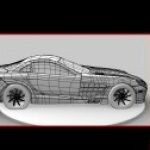Visual Effects Modeling and Texturing – VFX Basics Understanding
June 6, 2020 – The first-ever animation produced was in a French film called ‘Fantasmagorie’ in the year 1908 by artiste Émile Cohl. The movie depicted white 2D stick figures moving about on a black background. Fantasmagorie is considered to be the primal traditional hand-drawn animation film and hence, the first animated cartoon. In the year 1928, Walt Disney first aired the animated short film, ‘Steamboat Willie’ he produced in which he depicts a fairly 3D rendered Mickey Mouse in Black and White.
Animation and depiction of figures have come a long way since the early 1900s. The fully computer-animated movie produced was Toy Story in 1995. As evolution in computing and graphics catapulted exponentially, the media industry grew finer and realistic towards visual editing and thus, the conception of Visual Effects came into the picture.
Modeling:
Modeling can be defined as the process of creating a 3-Dimensional character, object, or even an environment from a 2-dimensional sketch or photograph using 3D rendering software like Autodesk Maya or Blender. Each and every curvature or contour of the 2D object is specified in the software which then renders a complete virtually build a 3D object. This object is known as a 3D model.
3D models see various applications in real-time. Apart from the media industry, 3D models are created in the medical field to study internal organs of patients by imaging multiple CT or MRI scans, many engineers use 3D modeling software like Auto CAD to render 3D designed vehicles and vehicular parts, architects use 3D concepts to build a virtual layout of their construction plan and game designers use 3D models to incorporate characters into the game they design.
The Modeling technique is responsible for shaping and adding volume to the nascent steps of CG and VFX process. Hence, it’s essential for Modeling artistes to be well versed in their concepts to avoid snowballing predicaments in the subsequent steps.

Texturing:
Ever heard of an Oxymoron? Texturing sure suits one. Well, in the realm of Computer Graphics Imagery and Visual Effects, making an object seem as realistic as its existence in the real world is the oxymoronic application of Texturing. Texturing can be defined as the process of adding color and details to a 3D model (character, object, or environment) rendered during texturing to make it look more real and lively.
Analogous to gift wrapping an object, in Texturing, an image is wrapped and applied over the 3D model to give it a visual relevance. The image is designed in appropriate proportions so as to align with the contour of the model when it swaddles over it. The texture of the image can range from being as smooth and uniform as a tile or as uneven and non-uniform as a crumpled fabric. Once the image is wrapped, the 3D model forges its resemblance to a real-world object or an imaginary one.
The widely used method to create textures is by using a 2D bitmapped image also called a textured map. As mentioned, the vectors inscribed over the image results in accurate alignment of the textured image over the 3D model.
Texturing in itself does not nudge life into the 3D model but certainly establishes an identity to it which is of paramount importance while designing in VFX.

Source: Massive VFX Studios
For more information, please visit at
This post was created with our nice and easy submission form. Create your post!








Comments
0 comments